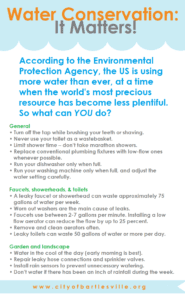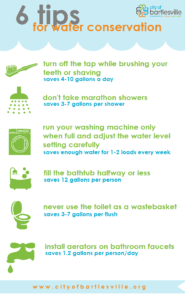

“The U.S. population has doubled over the past 50 years, while our thirst for water has tripled. With at least 40 states anticipating water shortages by 2024, the need to conserve water is critical,” the EPA website states.
The City of Bartlesville has taken many steps since the mid 2000s, when serious drought conditions nearly resulted in water rationing for local water customers, to help mitigate a future water crisis and ensure water supply for the area into the next several decades. One of those steps is the implementation of its water reuse system, which should be online by the end of 2023 to be used in extreme drought, should one occur.
The City also continually encourages the practice of water conservation for all its water customers, and offers the following guidelines to help you save money and contribute to the betterment of the planet.
Conservation: What you can do
Indoors, long showers are the largest user of what is arguably the world’s most precious resource. Limiting shower time, as well as updating plumbing fixtures to “low-flow” systems can go a long way in conserving water.
All new plumbing has ‘low-flow’ capabilities, which should replace conventional fixtures whenever possible.
Shower heads, toilets, sinks — all are available with water-saving low-flow aerators.
General
- Turn off the tap while brushing your teeth or shaving. (Save 4 to 10 gallons a day.)
- Never use your toilet as a wastebasket. (Save 3 to 7 gallons per flush.)
- Don’t take marathon showers. (Save 3 to 7 gallons per shower.)
- Run your dishwasher only when full. (Save up to 15 gallons per load.)
- Run the washing machine only when full and adjust the water level setting carefully. Your machine uses 22 to 25 gallons per load. (Save enough water for 1 to 2 loads every week; saves hot water cost, too.)


- A dripping, trickling or oozing faucet or showerhead can waste from 75 to several hundred gallons of water per week, depending on the size of the drip. Worn out washers are the main cause of these leaks, and a new washer generally cost about $1.
- Faucets typically use 2 to 7 gallons per minute. Installing a low-flow aerator can reduce the flow by as much as 25 percent — or up to a gallon and a half per minute. Remove and clean aerators often.
- Leaky toilets make trickling sounds and can waste 50 gallons of water a day or more. Parts are inexpensive and fairly east to replace.
Gardens and Landscape
- Water in the cool of the day (early morning is best), and repair leaky hose connections and sprinkler valves. Install rain sensors in timing devices to prevent watering when it’s unnecessary. And remember the One Inch Rule: If there has been an inch of rainfall during the week, you don’t need to water at all.
For more information, visit https://www.epa.gov/watersense.
